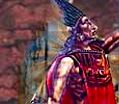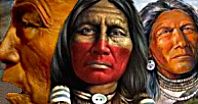|
|  |

CAHOKIA MOUNDS ANCIENT INDIAN CIVILIZATION

Cahokia Mounds art exhibit showcases moundbuilder artifacts: Hero, Hawk and Open Hand
AUTHOR: Victor M. Cassidy
Imagine for a moment that you are paddling up the Mississippi River near present-day St. Louis -- about 600 years ago. In the distance you notice a huge, flat-topped earthen mound. Stairs on its front face lead up to an impressive lodge with a sharply peaked roof.
A Town of 15,000
As you near this landmark, you see that it dominates a city surrounded by a wooden palisade. Inside are numerous earthen mounds, thatch-roofed houses with pole walls, farm plots, a market, a spacious central plaza and about 15,000 people.
This place, which we now call Cahokia, Ill., once covered more than five square miles of Mississippi bottomland. Carrying one basketful of earth at a time, the Cahokia Indians built the 100-foot-high mound that you saw from the river. The chief lived on top and the people thought him semi-divine. Cahokia left no written record, but some Indians engraved images on whelk shells that celebrated their gods and the deeds of brave men.
The Cahokia were one of many Indian tribes that built large settlements and ceremonial centers in the Midwestern and southern United States beginning more than 3,000 years before the birth of Christ. From 400 BC to about 400 AD, in present-day central Ohio, the Adena and Hopewell people constructed monumental earthen enclosures for their social, political, or religious ritual practices. There were major settlements in today's Louisiana, Oklahoma, Alabama and Georgia.
Many Indian civilizations disappeared before Europeans arrived
Many Indian civilizations disappeared before Europeans arrived, but 16th-century explorers encountered and described several of them intact, publishing illustrated books. Europeans brought epidemics that devastated many tribes. Settlers later drove out the remaining Indians and built farms, roads and homes on ancient sites. There was less destruction in the U.S. Southwest and in Central America, where the Indian tradition is deeply rooted and more visibly a part of the landscape.
Exhibit to open at the Saint Louis Art Museum March 4 to May 30, 2005
Richard Townsend, a curator at the Art Institute of Chicago, worked with historians, anthropologists, archaeologists and tribal representatives to organize an exhibition of 300 Indian objects, which he is presenting as works of art. Called "Hero, Hawk and Open Hand: Ancient Indian Art of the Midwest and South, " the show was up at the Art Institute in December and January. It opens at the Saint Louis Art Museum, Mar. 4-May 30, 2005.
According to Townsend, most Americans believe incorrectly that the Midwestern and southeastern Indian tribes "few and far between. " These native people, says the "myth, " were "wild savages " who did not create "early forms of civilization. " "Hero, Hawk and Open Hand " explodes this myth by showing that Native Americans built large settlements like Cahokia, established trade routes that brought them objects and materials from all over the North American continent, developed a complex religion, and supported a class of "full-time professional artisans, " who created objects of such distinction that they belong in an art museum. Townsend compares the objects in his show to those of early Mesopotamia.
Did such a myth ever exist? "Hero, Hawk and Open Hand " presents images of North American Indian cities that were made by the earliest European explorers. In 1848, the Smithsonian Institution commissioned Ephriam G. Squier and Edwin H. Davis to describe ancient monuments in the Mississippi valley and published their illustrated monograph. Townsend's catalogue repeatedly cites this and other 19th-century studies of Indian sites. Why would anyone have written such books if they thought the Indians were just savages? "Hero, Hawk and Open Hand " amplifies our understanding of Indian civilizations but it explodes no myth. We will return to this point later on.
What We See
"Hero, Hawk and Open Hand " presents things that have survived several centuries beneath the ground -- grave goods and useful objects made from stone, metal and clay. We see curious carved stone effigy pipes in animal form that Indians presumably passed from hand to hand during ceremonies, whelk shells with drawings carved into their surface, pottery and ceramic sculptures, and stone, shell, and metal jewelry.
Indian craftsmen, who were not encouraged to innovate, made these anonymous works and it would be easy to call them artifacts. But the objects, which come to us from a distant culture and time, embody the universal human desire to make art. Just like today's artists, the craftspeople had an itch in their hands to make things, to make them beautiful, to create visual symbols and to decorate.
We see eight chunkey stones, which Mississippi River tribes used in an outdoor game. A chunkey player rolled his stone along the ground (it looks like a giant hockey puck with a depression in its center) while rival players threw sticks or shot arrows to mark where the stone would stop. Two of the eight chunkey stones in the show seem almost industrial, but the others are carved from carefully selected pieces of conglomerate, greenstone, and quartz with their smooth exteriors finished to reveal rich colors, patterns, and lines within.
Indian artists made projectile points of deadly elegance -- razor-sharp arrowheads chipped perfectly from pieces of chert and spear points with neat rows of teeth that pierced the flesh and did not let go. We see a cache of arrowheads that archaeologists discovered in a Cahokia grave. Gorgeous but too delicate for use, they exemplify Indian art for art's sake.
The most striking objects are fragile Hopewell cutouts made from sheets of mica. An open, life-sized human hand with its unnaturally long fingers spread and a graceful curve around the heel of the palm conveys by its form a sense of communication between the human and the spirit world. This piece -- and mica carvings of a snake, bird claw and human profile -- probably decorated some sacred place because they would fall apart if they were carried on the human body.
"Hero, Hawk and Open Hand " includes a 15-minute video Produced by the Art Institute, the video is about ways that contemporary Indians preserve their culture. A craftswoman replicates some of the clay work in the show, commenting on its design. A Choctaw who teaches classes in the native language is interviewed. We watch a Caddo dancing club in native costume as it prepares to perform. The video, which is just sound bites strung together, communicates little about Indian culture or the theme of the show. We could just as well be watching Ukrainian ladies painting Easter eggs or the meeting of a tango society.
According to Townsend, the video connects today's Indians and the objects their ancestors made. He adds that all these people are part of North America's history. As crews went out to make the video, the tribes became very interested in Townsend's show and "we began to hear each others' voices, " he says.
Possibly so, but it seems that political correctness accounts for this video and for the proclamation -- and destruction -- of a non-existent "wild savages " myth. To obtain objects for "Hero, Hawk and Open Hand, " Townsend had to do absurd amounts of extracurricular diplomatic work. When he wanted to borrow carved marble seated male and kneeling female figures from the Etowah Indian Mounds State Historical Site in Georgia, he communicated with the museum in routine fashion. But he also had to obtain permission from five chieftains of the Muskogee-Creek tribe because the State of Georgia has an agreement with five Creek tribes under the federal Native Graves Protection and Repatriation Act of 1990 that gives the Indians a degree of control over the Etowah objects.
Today's Muskogee-Creek tribe
Today's Muskogee-Creek tribe claims that it can trace its ancestry to the Etowah culture that existed from AD 1000 to AD 1200. "There's not a direct continuity, " says Townsend. "The language and culture continue. " Since Etowah culture left no written records and vanished 800 years ago, it is impossible to prove or disprove such claims. But the law is the law and Townsend visited Georgia many times over the course of a year to obtain assent from the five chieftains. He brought some of them to the Art Institute so they could see what he had in mind for the carvings.
Townsend went to equal lengths to obtain other objects in "Hero, Hawk and Open Hand. " Despite such obstacles, he has produced a fresh, absorbing show. But a law that was written to protect Native Americans now drives a wedge between the public and these works. Don't expect to see many more exhibitions like this one.
ABOUT THE AUTHOR:
VICTOR M. CASSIDY writes on art from Chicago.
RELATED ARTICLES:
Mississippi Mound Builders Overview
Cahokia moundbuilders
Once the most numerous peoples in Florida, the Ais are now extinct
Role of Middle Mississippians in transfer of Late Woodland to Oneota culture
Cahokia Mounds State Historic Site
|
 |


|
|
| | | | | | | | |
 |
|
|

